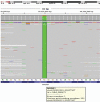Pediatric Primary Adrenal Insufficiency: A 21-year Single Center Experience
- PMID: 32938577
- PMCID: PMC7947721
- DOI: 10.4274/jcrpe.galenos.2020.2020.0132
Pediatric Primary Adrenal Insufficiency: A 21-year Single Center Experience
Abstract
Objective: Primary adrenal insufficiency (PAI) is a rare but potentially life-threatening condition. In childhood, PAI is usually caused by monogenic diseases. Although congenital adrenal hyperplasia (CAH) is the most common cause of childhood PAI, numerous non-CAH genetic causes have also been identified.
Methods: Patients aged 0-18 years and diagnosed with PAI between 1998 and 2019 in a tertiary care hospital were retrospectively evaluated. After the etiologic distribution was determined, non-CAH PAI patients were evaluated in detail.
Results: Seventy-three PAI patients were identified. The most common etiology was CAH (69.9%, n=51). Non-CAH etiologies accounted for 30.1% (n=22) and included adrenoleukodystrophy (ALD; n=8), familial glucocorticoid deficiency (n=3), Triple A syndrome (n=5), autoimmune adrenalitis (n=1), adrenal hypoplasia congenital (n=1), IMAGe syndrome (n=1), and other unknown etiologies (n=3). The median age at the time of AI diagnosis for non-CAH etiologies was 3.52 (0.03-15.17) years. The most frequent symptoms/clinical findings at onset were hyperpigmentation of skin (81.8%), symptoms of hypoglycemia (40.9%), and weakness/fatigue (31.8%). Hypoglycemia (50.0%), hyponatremia (36.4%) and hyperkalemia (22.7%) were prominent biochemical findings. Diagnosis of specific etiologies were proven genetically in 13 of 22 patients. A novel p.Q301* hemizygous frameshift mutation of the DAX1 gene was identified in one patient.
Conclusion: Etiology was determined in 86.3% of children with non-CAH PAI through specific clinical and laboratory findings with/ without molecular analysis of candidate genes. ALD was the most common etiology. Currently, advanced molecular analysis can be utilized to establish a specific genetic diagnosis for PAI in patients who have no specific diagnostic features.
Keywords: Primary adrenal insufficiency; pediatric; etiology.
Figures
Similar articles
-
Etiology of primary adrenal insufficiency in children: a 29-year single-center experience.J Pediatr Endocrinol Metab. 2019 Jun 26;32(6):615-622. doi: 10.1515/jpem-2018-0445. J Pediatr Endocrinol Metab. 2019. PMID: 31141483 Clinical Trial.
-
Insights in non-CAH pediatric primary adrenal insufficiency: a single-center experience from India.J Pediatr Endocrinol Metab. 2025 Feb 4;38(4):383-390. doi: 10.1515/jpem-2024-0476. Print 2025 Apr 28. J Pediatr Endocrinol Metab. 2025. PMID: 39898459
-
Primary adrenal insufficiency in children excluding congenital adrenal hyperplasia: insights from 33-year single-center experience in Tunisia.Arch Pediatr. 2025 Jan 27:S0929-693X(25)00019-3. doi: 10.1016/j.arcped.2024.10.010. Online ahead of print. Arch Pediatr. 2025. PMID: 39875217
-
The multiple faces of autoimmune Addison's disease in children.Front Endocrinol (Lausanne). 2024 Sep 16;15:1411774. doi: 10.3389/fendo.2024.1411774. eCollection 2024. Front Endocrinol (Lausanne). 2024. PMID: 39351530 Free PMC article. Review.
-
Rare monogenic causes of primary adrenal insufficiency.Curr Opin Endocrinol Diabetes Obes. 2018 Jun;25(3):172-177. doi: 10.1097/MED.0000000000000401. Curr Opin Endocrinol Diabetes Obes. 2018. PMID: 29373482 Review.
Cited by
-
The etiology and clinical features of non-CAH primary adrenal insufficiency in children.Front Pediatr. 2022 Aug 19;10:961268. doi: 10.3389/fped.2022.961268. eCollection 2022. Front Pediatr. 2022. PMID: 36061374 Free PMC article.
-
Long-Term Follow-Up of Three Family Members with a Novel NNT Pathogenic Variant Causing Primary Adrenal Insufficiency.Genes (Basel). 2022 Apr 20;13(5):717. doi: 10.3390/genes13050717. Genes (Basel). 2022. PMID: 35627102 Free PMC article.
-
Congenital Adrenal Hyperplasia and Adrenal Insufficiency in Children: An Evidence-based Review with Good Practice Points by Adrenal Working Group of The Turkish Society for Pediatric Endocrinology and Diabetes.J Clin Res Pediatr Endocrinol. 2025 Jan 10;17(Suppl 1):1-2. doi: 10.4274/jcrpe.galenos.2024.2025-1-4-S. J Clin Res Pediatr Endocrinol. 2025. PMID: 39801111 Free PMC article. No abstract available.
-
Neglected Adrenal Hypoplasia Congenita in Two Siblings with Novel Genetic Mutations in NR0B1 Gene and Notable Clinical Course: A Case Report.Endocr Metab Immune Disord Drug Targets. 2024;24(14):1704-1708. doi: 10.2174/0118715303285405240202092244. Endocr Metab Immune Disord Drug Targets. 2024. PMID: 38409716
-
The Causes and Diagnosis of Non-congenital Adrenal Hyperplasia Primary Adrenal Insufficiency in Children.J Clin Res Pediatr Endocrinol. 2025 Jan 10;17(Suppl 1):66-71. doi: 10.4274/jcrpe.galenos.2024.2024-6-24-S. Epub 2024 Dec 23. J Clin Res Pediatr Endocrinol. 2025. PMID: 39713889 Free PMC article.
References
-
- Ventura M, Serra-Caetano J, Cardoso R, Dinis I, Melo M, Carrilho F, Mirante A. The spectrum of pediatric adrenal insufficiency: insights from 34 years of experience. J Pediatr Endocrinol Metab. 2019;32:721–726. - PubMed
-
- Flück CE. Mechanısms In Endocrınology: Update on pathogenesis of primary adrenal insufficiency: beyond steroid enzyme deficiency and autoimmune adrenal destruction. Eur J Endocrinol. 2017;177:99–111. - PubMed
-
- Hsieh S, White PC. Presentation of primary adrenal insufficiency in childhood. J Clin Endocrinol Metab. 2011;96:925–928. - PubMed
-
- Arlt W, Allolio B. Adrenal insufficiency. Lancet. 2003;361:1881–1893. - PubMed
-
- Perry R, Kecha O, Paquette J, Huot C, Van Vliet G, Deal C. Primary adrenal insufficiency in children: twenty years experience at the Sainte- Justine Hospital, Montreal. J Clin Endocrinol Metab. 2005;90:3243–3250. - PubMed
MeSH terms
LinkOut - more resources
Full Text Sources
Other Literature Sources
Medical

